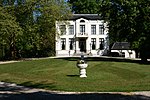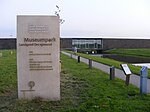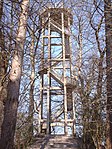Oranjewoud
Oranjewoud ( Frisian : It Oranjewâld ) is a village in the municipality of Heerenveen , province of Friesland ( Netherlands ), east of Heerenveen. Oranjewoud is located in the west of the wooded Oranjewoud Park . In the 1990s, the Oranjewoud-Noord residential area was built.
history

The area was called Schoterwold , or 't Wold for short, before it was bought by Princess Albertine Agnes of Nassau. It was heavily forested area in the Grietenei Schoterland . The settlement dates back to the 11th century.
The name Oranjewoud is derived from the gender of the Orange people . In 1676 the Princess of Oranje Albertine Agnes von Oranien-Nassau , the widow of Prince Wilhelm Friedrich von Nassau-Dietz , bought an estate known as Sickingastate and three farms and gave the whole thing the name Oranjewoud. Such a summer residence was quite fashionable at the time. She had long avenues, canals and gardens built in the Baroque style based on the French model. After Albertine Agnes' death, her daughter-in-law Henriette Amalie von Anhalt-Dessau inherited the property. The architect Daniel Marot , known for the palace Het Loo , designed the Palais Oranjewoud in a classical style with baroque elements on their behalf . First the two side wings were built, but the middle main building was never built. The side wings were 15 window openings wide. The governors lived there regularly until 1747. It then became the apartment of William IV (Orange) . His mother Marie Luise von Hessen-Kassel was the last inhabitant of the palace. In 1777 Willem V van Oranje-Nassau paid a visit to the palace. The side wings were torn down in 1803 and 1805, and the estate was sold in 1813. In addition to the Palais Oranjewoud, the House of Orange in Oranjewoud also bought a small castle, the Carolineburg , which was probably named after Karoline von Oranien-Nassau-Diez , the daughter of William IV of Orange . Carolineburg had side wings, a curtain wall and several portals. In 1774 it was sold and demolished.
Estates
At the beginning of the 19th century, various noble families settled in Oranjewoud. For example, shortly after 1834 Hans Willem de Blocq van Scheltinga had a new country house built on the property of the demolished Oranjewoud Palace, which he also called Oranjewoud. This new house was no longer owned by the royal family. However, members of the royal family still visited this estate from time to time, for example King Wilhelm I , Wilhelm III. or Princess Juliana . But also Prince Heinrich of Orange-Nassau , Prince Bernhard , Princess (later Queen) Beatrix and her husband Prince Claus were guests here.
Finally, the estate was sold by the heirs to the Institute for Cooperation in Agriculture (Instituut voor Landbouwcoöperatie). At the moment it is in the presence of the Friesland bank . On the former property of the governor's family, the Oranjestein house still stood , a renter's apartment that was bought in 1820 by Pieter Cats, a lawyer from Sneek . Cats had the house rebuilt in a neoclassical style. In 1856 Cats built another villa called Kleine Jagdlust , also on the former property of the royal governors. At the moment only Oranjestein is inhabited. Other estates still in existence are Oranjehoeve, Princenhof and Klemburg. The Ontwijk, Brouwershave, Veenzigt and Paauwenburg estates no longer exist.
Attractions
Monuments
A large part of Oranjewoud is a listed building.
Culture
- The Oranjewoud Festival has been held annually in Oranjewoud since May 2012 . Classical concerts are given in the country estates, in the Belvedere Museum and in the Overtuin.
schools
- Primary school: Albertine Agnesschool.
Well-known people from Oranjewoud
- Duke Wilhelm Heinrich of Saxe-Eisenach (1691–1741)
- Cissy van Marxveldt (= Setske de Haan, 1889–1948), writer for children's books
- Chris Fokma (1927), sculptor
- Henk Evers , (1939), athlete
- Ype Dijkstra (1944), Mayor
Web links
- Website of the municipality of Heerenveen about Oranjewoud
- Website of the village of Oranjewoud
- Oranjewoud in the local guide
literature
Auke Broersma / Christiaan Visser: Landgoedwandeling Oranjewoud. Edited by Staatsbosbeheer / Museum Belvedere 2016





